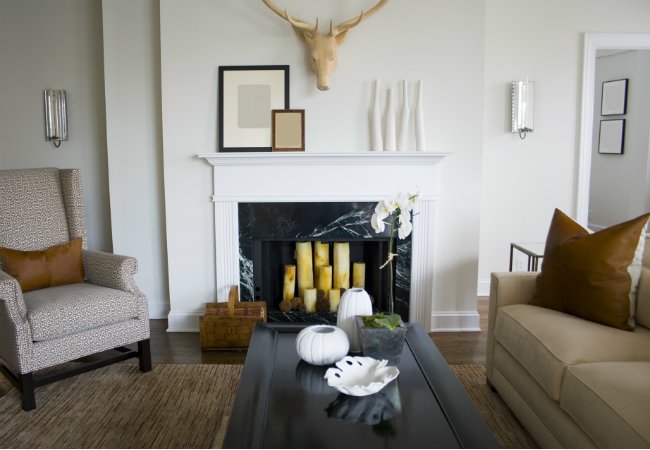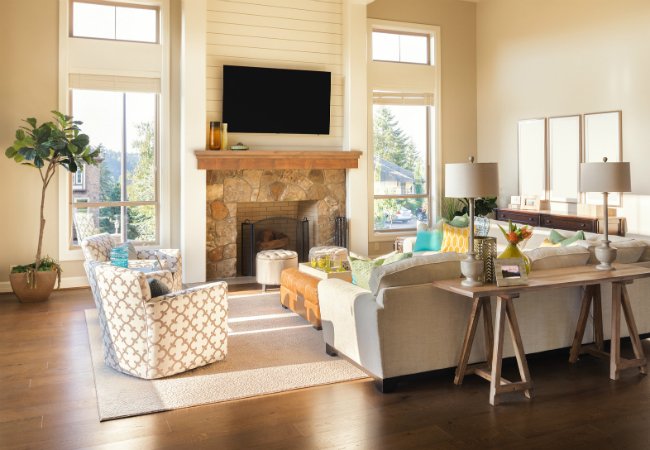

We may earn revenue from the products available on this page and participate in affiliate programs. Learn More ›
You can repaint the walls, re-carpet the floor, and replace all outdated furniture, but leaving that eyesore of an old fireplace untouched in a room refresh will only hold your new design back. Fireplaces are natural focal points, so the condition of yours sets the stage for the whole room. Since tearing it out can be both messy and costly, many homeowners opt for a more cost-efficient alternative: fireplace refacing. This process focuses on updating just the surface of the fireplace without changing how the room’s heating operates at all. As a result, so that you can modernize the look of the entire room—all while reigning in your DIY project’s timeline and budget!
Design Options Materials
The first major consideration when committing to refacing the fireplace involves selecting the ideal materials. Today’s homeowners have many options from which to choose: Smooth concrete, new tile, granite, rustic brick, even wood can breathe new life into an outdated fireplace surround. Whether your hearth is operable or just for looks, there is a fireplace refacing material available and ideal for installation.

Concrete or Stucco
Concrete or stucco mix can be applied by hand directly to the surface of an existing masonry fireplace, then either troweled smooth or a finished with a texture to suit the space. Both DIY products come as dry powdered mixes to be combined with water when you’re ready—and very affordable supplies, at that. A bag of either concrete or stucco mix costs about $9 and will cover approximately 25 sq ft of fireplace when applied 3/8-inch thick.

Wood
Wood fireplace facing lends a warm, natural appearance to a structure known to physically keep a room toasty. Leave it unfinished for rustic vibes, or coat with stain or paint for a traditional (even crisp and clean) look. Both paneling and thin wood boards work well to cover the existing fireplace. Depending on which you choose and its variety of wood, your fireplace refacing supplies can range from less than $1 per foot of board for common 1″-thick pine to over $12 per foot of board for mahogany, walnut, and more exotic hardwoods. Before buying in bulk to reface a working fireplace, consult your local fire codes to know the limitations. The International Building Code prohibits the installation of any combustible material, including wood, within 6 inches of the sides of a working fireplace. Local fire codes vary—even be more restrictive—so if you’re redesigning the area around an operable fireplace, contact your local building authority for the rules in your community first.

Masonry
Masonry veneers, sometimes called “thin brick” or “thin stone,” are manufactured to look nearly identical to their real brick and stone namesakes—at a fraction of their weight and thickness. The microscopic differences between an installed veneer and the real thing make veneer a top choice for an authentic fireplace look. Depending on the brand and the pattern of brick or stone you choose (there are many), veneer sheets range in price from $5 to $15 per sq ft.

Tile
Tile is a rather traditional fireplace refacing material, available in nearly limitless choices of color and design. Install it yourself, and this option can even be affordable! Tiles range from under $1 per sq ft to as much as $15 per sq ft, depending on brand and type.

Stone
The same type of stone slabs commonly used for kitchen backsplashes and shower walls can be brought into the living space as fireplace refacing materials. Choose from slate, granite, quartz, soapstone, and more to suit your individual style, but know that the real deal will cost you. Stone slabs are pricier than other refacing materials, starting around $50 per sq ft for granite and quartz and around $70 a sq ft for soapstone and slate. That’s just a starting point, though: Costs can exceed $100 per sq ft for slabs with desirable hues and patterns!

What to Expect from Installation
As can be expected, installation varies by the type of material you choose and the look you aim to achieve. The simplest and therefore most popular refacing technique involves installing the new materials directly over the existing fireplace surround or, if there is none, the neighboring drywall. This method is suitable only when the existing materials are in good shape—that means no loose bricks or crumbling tiles, so give it a close inspection before you begin. If your current surround is in poor shape or you’d prefer that the new fireplace takes on a different size (short and squat or a grand floor-to-ceiling treatment), your first task involves disassembling the old fireplace facing so that you install directly on the drywall behind it.
Masonry veneers are designed to follow a very straightforward installation process. These adhere directly to existing masonry using a coat of veneer mortar (an adhesive compound strong enough to secure the lightweight refacing materials) that comes recommended by the manufacturer. If you want to install masonry veneers over wood or drywall, though, you must first attach metal lath to the wall; the box of materials should offer an easy-to-follow step-by-step from the manufacturer.
Wood paneling or wood boards, on the other hand, need something more to attach to. Typically, installing wood facing over masonry is a two-part process: First mount batts (thin wood boards) to the masonry with concrete screws and then install the wood facing over these with regular screws or nails. Hide any divots where you’ve drilled or hammered by filling with wood putty, and a coat of stain or paint can transform the new structure from a minimalist feature to a more traditionally sleek piece of architecture.
Tile or stone slabs require the surface beneath be very flat for installation, often accomplished by skimming the surface flat with mortar before installing the fireplace refacing material of choice. Tile and stone can even be installed directly over drywall, so long as you use the right mortar: Ceramic tile requires ceramic tile mortar, porcelain tile requires porcelain tile mortar and stone slab manufacturers may call for veneer mortar. While small tile and slab projects are DIY-friendly—say, covering the brick portion of a fireplace that features masonry nearest the fireplace opening and frames the structure with a wood surround—you may want to call in a professional tile setter or mason to at least get a quote on a fireplace refacing project that will encompass an entire wall.

Mantel or No Mantel?
Rustic fireplaces often boast bulky mantels that add to their log-cabin appeal, but a concrete fireplace without any mantel at all can look spectacular in a contemporary setting—particularly when its floor-to-ceiling height isn’t chopped by a horizontal ledge. Ultimately, whether or not you incorporate a shelf mantel in your refacing project depends on your desired style.
Similar to the use of wood as a facing material, if you want to install a wood mantel over a working fireplace, fire codes will apply. In general, a mantel that extends an average of 1.5-inches outward from the wall, should be positioned no closer than 12 inches from the top of the fireplace opening. The farther the mantel extends outward, the greater the amount of clearance it needs. Always check with the local authorities to be on the safe side.
Mantels can be made from scratch, purchased new, or even saved from another construction. If your existing fireplace has a gorgeous mantle, there’s no reason you have to get rid of it in this room refresh—it can be removed and reinstalled over whatever new refacing material you choose. Or check out secondhand stores that carry old building materials, like the Habitat for Humanity ReStore, for a deal on a ready-made mantel.
Once you’ve chosen your mantel, keep in mind that the heavy ledges must be adequately supported by attaching them with long bolts directly into wall studs to hold their weight. Beefy, oversized mantels, depending on their weight, may require additional reinforcement in the form of installing stud backers in the wall before the mantel can be hung. The extra time and care that you take ensuring a proper installation will then ease concerns about any of your home decor crashing down later, providing enough peace of mind to relax in your wholly redesigned living space.
